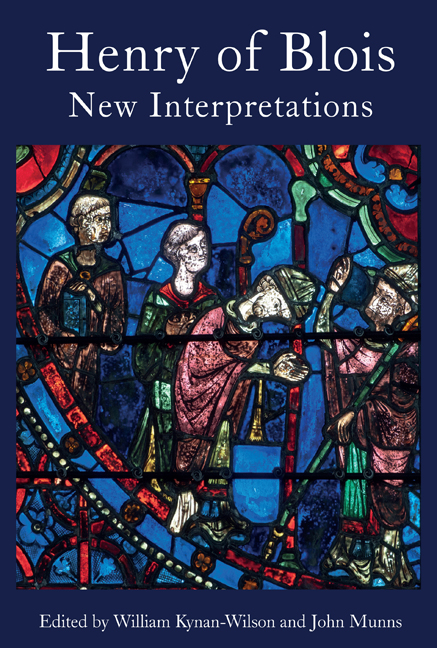Book contents
- Frontmatter
- Dedication
- Contents
- List of Illustrations
- List of Contributors
- Acknowledgements
- List of Abbreviations
- Genealogical Table: The Family Connections of Henry of Blois
- Introduction: Approaches to Henry of Blois
- 1 Causa Dei Et Ecclesie Cluniacensis: Henry of Blois and Cluny
- 2 Henry of Blois and His Legation in England
- 3 The Episcopal Colleagues of Henry of Blois
- 4 The Architectural Heritage of Bishop Henry of Blois at Winchester Cathedral
- 5 Wolvesey: Henry of Blois’ Domus Quasi palatium in Winchester
- 6 Bishop Henry’s Bible
- 7 Henry of Blois and the Construction of Roman Identity
- 8 Henry of Blois: Between Patronage and Representation in the Long Twelfth Century
- 9 The Last Days of Henry of Blois
- Timeline
- Bibliography
- Index
- Plate Section
6 - Bishop Henry’s Bible
Published online by Cambridge University Press: 09 February 2021
- Frontmatter
- Dedication
- Contents
- List of Illustrations
- List of Contributors
- Acknowledgements
- List of Abbreviations
- Genealogical Table: The Family Connections of Henry of Blois
- Introduction: Approaches to Henry of Blois
- 1 Causa Dei Et Ecclesie Cluniacensis: Henry of Blois and Cluny
- 2 Henry of Blois and His Legation in England
- 3 The Episcopal Colleagues of Henry of Blois
- 4 The Architectural Heritage of Bishop Henry of Blois at Winchester Cathedral
- 5 Wolvesey: Henry of Blois’ Domus Quasi palatium in Winchester
- 6 Bishop Henry’s Bible
- 7 Henry of Blois and the Construction of Roman Identity
- 8 Henry of Blois: Between Patronage and Representation in the Long Twelfth Century
- 9 The Last Days of Henry of Blois
- Timeline
- Bibliography
- Index
- Plate Section
Summary
In the centre of the choir of Winchester Cathedral, in front of the high altar, lies a plain Purbeck marble tomb; unadorned, shiny and black [Plate XI]. Close to it stands a plaque bearing a modern inscription which reads: ‘This tomb may contain the remains of Henry of Blois, Bishop of Winchester 1129–1171. He was brother of King Stephen, founded the Hospital of St Cross and inspired the creation of the Winchester Bible.’ It identifies a tomb which is surprisingly modest for a bishop of such importance, particularly one known in his own day for his wealth, his love of beautiful things and fine materials, and his enthusiasm for creating great buildings and works of art. Documents confirm that the bishop founded the Hospital of St Cross between 1132 and 1136, however, there is no written evidence to connect him with the Bible (Winchester Cathedral Library, MS 17). Even so it has generally been accepted that this is Henry's Bible, not just as a matter of coincidence of time and place, nor (as has recently been suggested) a wish to connect obviously great but ‘anonymous’ works with important people. The qualities we see in this Bible match those that we find in the bishop's many other works. This is just the sort of book he would want to have had made.
When I first wrote about the Bible in 1993 this seemed evident if not proved, and I wrote a small section on ‘The Patronage of Henry of Blois’, stating (what I still believe) that ‘the layout of the manuscript and its script date to c. 1160 when Henry of Blois was bishop of Winchester’ and that ‘His interests in the arts were clearly those of a lavish-spending patron’. Furthermore I declared, perhaps rather too boldly, that ‘A portrait of a bishop, grandly arrayed and with a red volume beneath his arm … surely confirms his importance to the considerable undertaking this manuscript represents’. That was then. On the whole I still agree with those earlier views. But I did have doubts. This manuscript is far from straightforward. Much has been written about it, but there remain paradoxes and anomalies for which many different explanations have been given.
- Type
- Chapter
- Information
- Henry of BloisNew Interpretations, pp. 145 - 184Publisher: Boydell & BrewerPrint publication year: 2021



